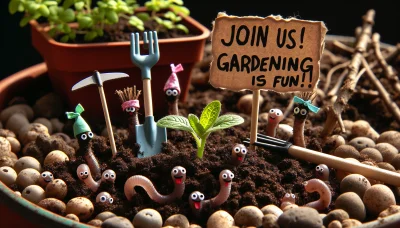Geranium perennial Quiz
Test Your Knowledge
Question of
Introduction to Geranium Perennials
Geranium perennials, often known for their vibrant blooms and hardy nature, play a pivotal role in gardening. Unlike their annual counterparts, these plants return year after year, making them a staple in perennial gardens. They are celebrated for their wide range of colors, from soft pinks to bold blues, and their ability to thrive in various conditions, from full sun to partial shade. Geraniums are not only aesthetically pleasing but also serve as an essential part of a garden's ecosystem, attracting pollinators such as bees and butterflies. Their versatility and low maintenance requirements make them an excellent choice for both novice and experienced gardeners looking to add long-lasting beauty to their outdoor spaces.
Types of Geranium Perennials
- Geranium Rozanne (Geranium 'Gerwat' Rozanne)
- Bloody Cranesbill (Geranium sanguineum)
- Geranium Brookside
- Geranium Johnson's Blue
- Mourning Widow (Geranium phaeum)
- Geranium Patricia
- Geranium Orion
- Geranium sylvaticum 'Mayflower'
How to Plant and Care for Geranium Perennials
Geranium perennials are a popular choice for gardeners looking to add vibrant color and life to their gardens. These hardy plants are relatively easy to care for, but there are a few key things to keep in mind to ensure they thrive. Here's how to plant and care for geranium perennials.
Soil Requirements: Geraniums prefer well-drained soil that's rich in organic matter. Before planting, work some compost into the soil to improve its structure and nutrient content. If your soil is heavy clay, consider raising the beds or adding sand and organic matter to improve drainage.
Sunlight Needs: These plants love the sun and require at least six hours of direct sunlight each day. While they can tolerate partial shade, too little sunlight can lead to leggy plants and fewer blooms. Choose a planting spot that gets plenty of sunlight throughout the day.
Planting: When planting geraniums, space them about 12 to 24 inches apart to ensure they have enough room to grow. Dig a hole slightly larger than the root ball, place the plant in the hole, and fill it in with soil. Gently pat the soil around the base of the plant to remove any air pockets.
Watering Tips: Geraniums need regular watering, especially during hot, dry periods. However, it's important to avoid overwatering, as this can lead to root rot. Allow the soil to dry out slightly between waterings. A good rule of thumb is to water deeply once a week, adjusting based on rainfall and temperature.
With the right care, your geranium perennials will bloom beautifully throughout the growing season, adding color and charm to your garden. Remember to deadhead spent blooms to encourage new growth and to fertilize every four to six weeks with a balanced, water-soluble fertilizer to support their vibrant displays.
Common Pests and Diseases Affecting Geranium Perennials
- Aphids: Small, soft-bodied insects that can be green, black, brown, or pink. They suck sap from the plants, weakening them and potentially spreading viruses. To manage aphids, you can rinse them off with a strong stream of water or use insecticidal soaps.
- Botrytis Blight: A fungal disease that causes gray mold on flowers, leaves, and stems, especially in wet, cool conditions. Improve air circulation around the plants and remove any infected parts promptly. Fungicides can be applied as a preventive measure.
- Rust: This fungal disease produces orange to brown pustules on the undersides of leaves. It thrives in moist conditions. To control rust, ensure good air circulation, avoid overhead watering, and remove affected leaves. Fungicides may also be used as needed.
- Whiteflies: Tiny, white, moth-like insects that feed on the underside of leaves, causing yellowing and weakening of the plant. They can also spread viruses. Use yellow sticky traps to monitor and reduce their numbers, and apply insecticidal soap or neem oil for control.
- Root Rot: A condition often caused by overwatering, leading to decay of the roots. Symptoms include wilting, yellowing, and stunted growth. Ensure good drainage and avoid overwatering to prevent root rot. Infected plants should be removed and discarded.
Benefits of Growing Geranium Perennials
Growing geranium perennials in a garden offers a multitude of environmental and aesthetic benefits that can greatly enhance both the garden's ecosystem and its visual appeal. These hardy plants not only bring vibrant colors and varied textures to garden spaces but also play a crucial role in supporting local biodiversity.
From an environmental perspective, geraniums are known for their resilience and low maintenance requirements. They require less water than many annuals, making them an excellent choice for sustainable gardening practices. Additionally, geraniums can help improve soil health by preventing erosion and promoting beneficial microbial activity. Their flowers and foliage serve as a habitat and food source for a variety of pollinators, including bees, butterflies, and hummingbirds, thus contributing to the conservation of these crucial species.
Aesthetically, geraniums offer a wide range of colors, shapes, and sizes, allowing gardeners to create diverse and visually appealing landscapes. Whether used as border plants, groundcovers, or accents in containers, geraniums can complement any garden design. Their continuous blooming cycle from late spring through fall ensures that gardens remain vibrant and colorful throughout the growing season. Furthermore, some varieties of geraniums release a pleasant fragrance, adding another layer of sensory enjoyment to the garden experience.
In conclusion, incorporating geranium perennials into a garden not only enhances its beauty but also promotes a healthier and more sustainable environment. With their environmental benefits and aesthetic appeal, geraniums are a fantastic choice for gardeners looking to create lively, resilient, and eco-friendly garden spaces.
Design Ideas with Geranium Perennials
Geranium perennials are versatile plants that can add beauty and vibrancy to any garden landscape. With their lush foliage and colorful blooms, they can serve as an excellent ground cover or a delightful accent in flower beds and borders. Here are some design ideas and tips for incorporating geranium perennials into your garden:
- Use geraniums to edge pathways or garden borders, creating a soft, inviting boundary.
- Combine different shades of geraniums for a vibrant and colorful display that lasts throughout the growing season.
- Plant geraniums in containers or hanging baskets to add height and texture to your garden or patio area.
- Incorporate geraniums into a rock garden to add bursts of color among the stones and succulents.
- Pair geraniums with taller perennials or shrubs as a backdrop to create a layered look in your garden beds.
- Choose geranium varieties with foliage that changes color in the fall for extended seasonal interest.
FAQs on Geranium Perennials
| Question | Answer |
|---|---|
| What are geranium perennials? | Geranium perennials, often referred to as cranesbill geraniums, are a group of plants known for their attractive foliage and flowers. They return year after year and are different from the annual geraniums found in most gardens. |
| How often should I water my geranium perennials? | Water them deeply once a week, allowing the soil to dry out between waterings. Overwatering can lead to root rot, so it's important to ensure good drainage. |
| Do geranium perennials need full sun? | While they can tolerate partial shade, geranium perennials thrive in full sun. They need at least 6 hours of sunlight a day for optimal growth and flowering. |
| When is the best time to plant geranium perennials? | The best time to plant geranium perennials is in the spring after the last frost. This gives them ample time to establish roots before the hot summer months. |
| How do I prune geranium perennials? | Prune them in late summer or early fall to remove dead or damaged foliage and encourage bushier growth. Avoid heavy pruning as this can stress the plants. |
| Can geranium perennials survive winter? | Yes, geranium perennials can survive winter. In colder climates, it's beneficial to apply a layer of mulch around the base to protect the roots from freezing temperatures. |
| How long do geranium perennials live? | With proper care, geranium perennials can live for many years, often exceeding a decade. Their lifespan varies depending on the variety and growing conditions. |












